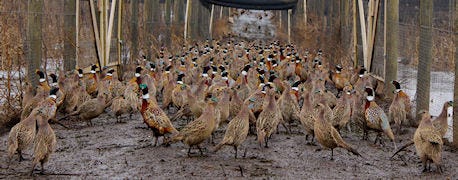January 19, 2015

By Ethan Giebel
MacFarlane Pheasants, Inc. is the largest producer of pheasants in North America and well noted as a leader in the game bird industry. Founded by the MacFarlane family in 1929, this Janesville farm carries on an 85-year legacy in the pheasant business. Bill MacFarlane is the second generation on the farm and serves as owner and president.
What does it take to operate a successful pheasant farm?

This group of birds awaits sorting at McFarlane Pheasants, Inc. in Janesville.
"Communication is the first hurdle to success in any business," said MacFarlane. "With the farm's operation spread over 500 acres, 20 employees carry walkie talkie's to be in constant communication. Having all employees know the goals and vision of the farm is the second hurdle. Keeping our goals in mind keeps us efficient and allows us to grow the best birds." It takes a team of 60 employees to effectively run MacFarlane Pheasants.
MacFarlane maintains that his philosophy is one of transparency when it comes to working with other growers and his customers. "I aspire to be as open as possible about what we do," said MacFarlane. "There aren't any secrets to the way we grow pheasants. Since 1998, we have been hosting a seminar every other year for growers in this industry to share ideas. Although we are competitors, we are also friends." Blogging is another way for others to get the scoop on the pheasant business. A visit to www.gamebirdexpert.com reveals up to date posts on the farm's day-to-day operations.
First and foremost, MacFarlane Pheasants is in the game bird business. In 2014, more than one million pheasant chicks were shipped to customers throughout North America. With the purchase of chicks, customers also receive valuable how-to advice on raising pheasants. About 435,000 adult pheasants were grown on the farm in 2014 to be sold for release. Over 100,000 adult partridges were sold by the farm as well, something that wouldn't have been found in years past.
From February through June, 45,000 pheasant breeding hens lay the eggs necessary to fill demand. Over the summer months, birds are raised outside on 200 acres of farmland in covered pens built from wooden poles, wire mesh sides and a netted top. This method of housing allows the pheasants to stay in and keeps the predators out. A cover crop of corn, milo or lamb's quarter is planted in each pen for the pheasants to utilize as refuge. A pelleted feed provides a complete ration for the pheasants to reach their growth potential. Demand for live chicks and adult birds is high, with customers from places as far away as Quebec, Canada, Oregon and Florida.
While typical ring-necked and Manchurian pheasants are raised for range environments, white pheasants are raised for processing purposes. MacFarlane identifies the processed pheasant products side of the business as the area with the most growth potential. In 2014, 170,000 pheasants were processed and primarily sold through wholesale vendors. This season, he expects that number to climb to upwards of 220,000 birds.
"White pheasants have been bred to carry more breast meat than traditional pheasants, thus making pheasant a more affordable option for the dinner table," said MacFarlane. "Our customers believe pheasant is a healthy choice. Pheasant has higher protein levels than most other meats while also having a lower cholesterol level."
McFarlane notes, "This didn't happen quickly. My father asked me to come back to the farm in 1979 after I graduated college. At the time we raised only 18,000 birds, the growth has been steady since that time. Growing infrastructure and a team of talented employees comes before building more pens."
Sophisticated marketing techniques have enabled MacFarlane to expand the reach of his product. In 1994, MacFarlane secured the URL www.pheasant.com.
"We have taken a very active role in using social media to engage our customers in conversation," said MacFarlane. "Building a relationship with the customer is important to me. Facebook, LinkedIn, Pinterest and our blog are some of the tools we use to do exactly that."
Customers can find MacFarlane pheasant in stores, restaurants and online at www.pheasantfordinner.com.
Geibel is a student at University of Wisconsin-Platteville.
You May Also Like




